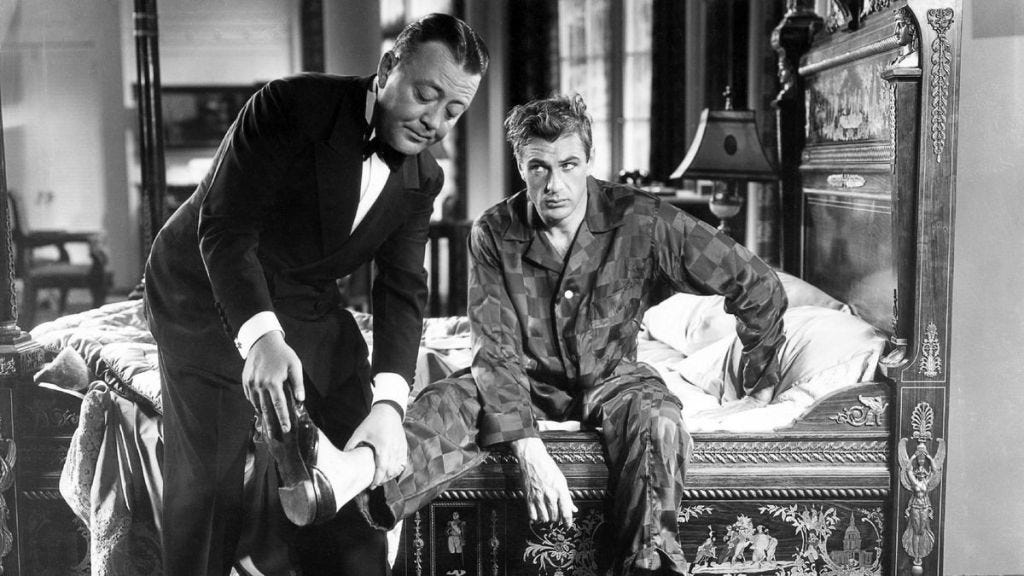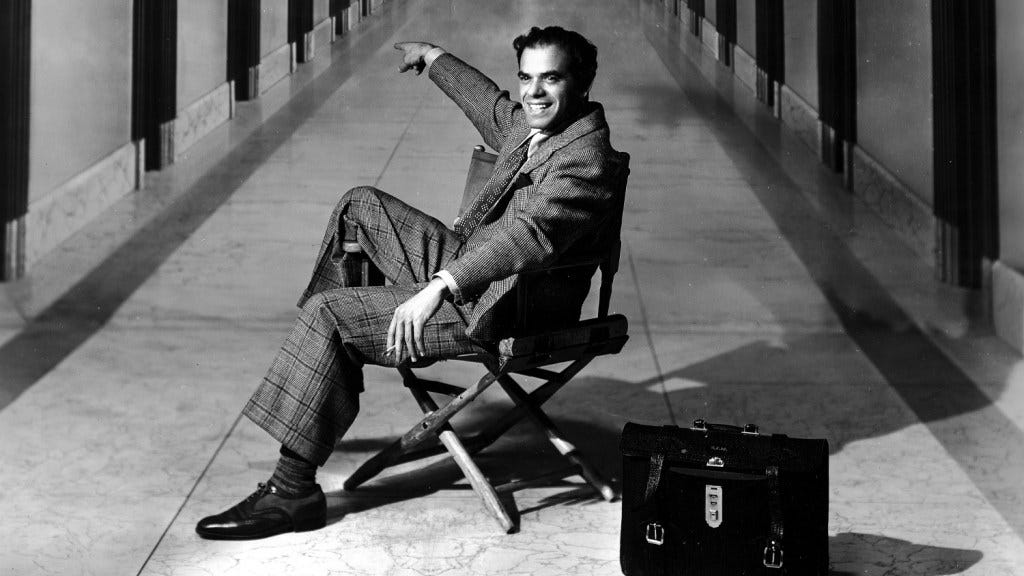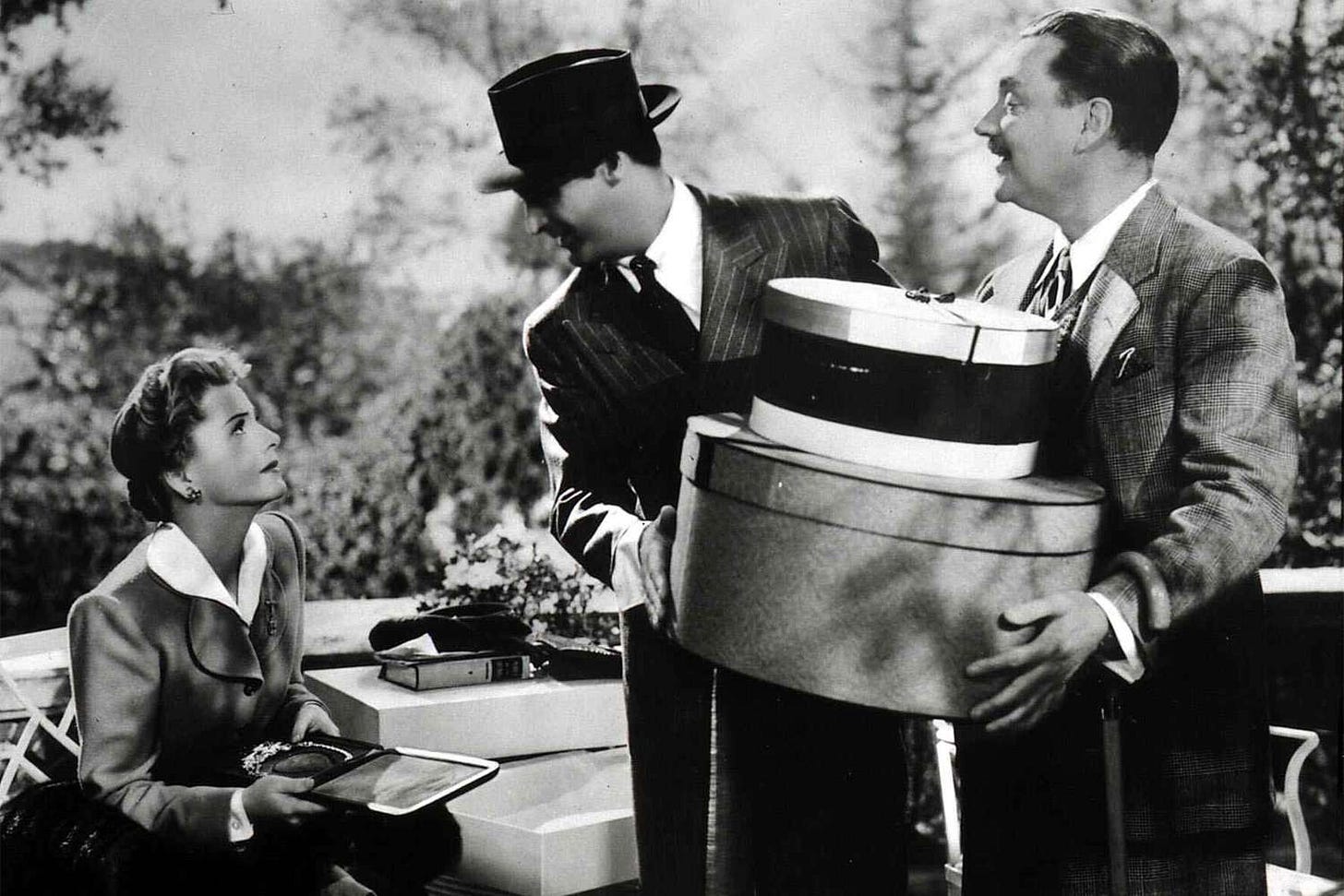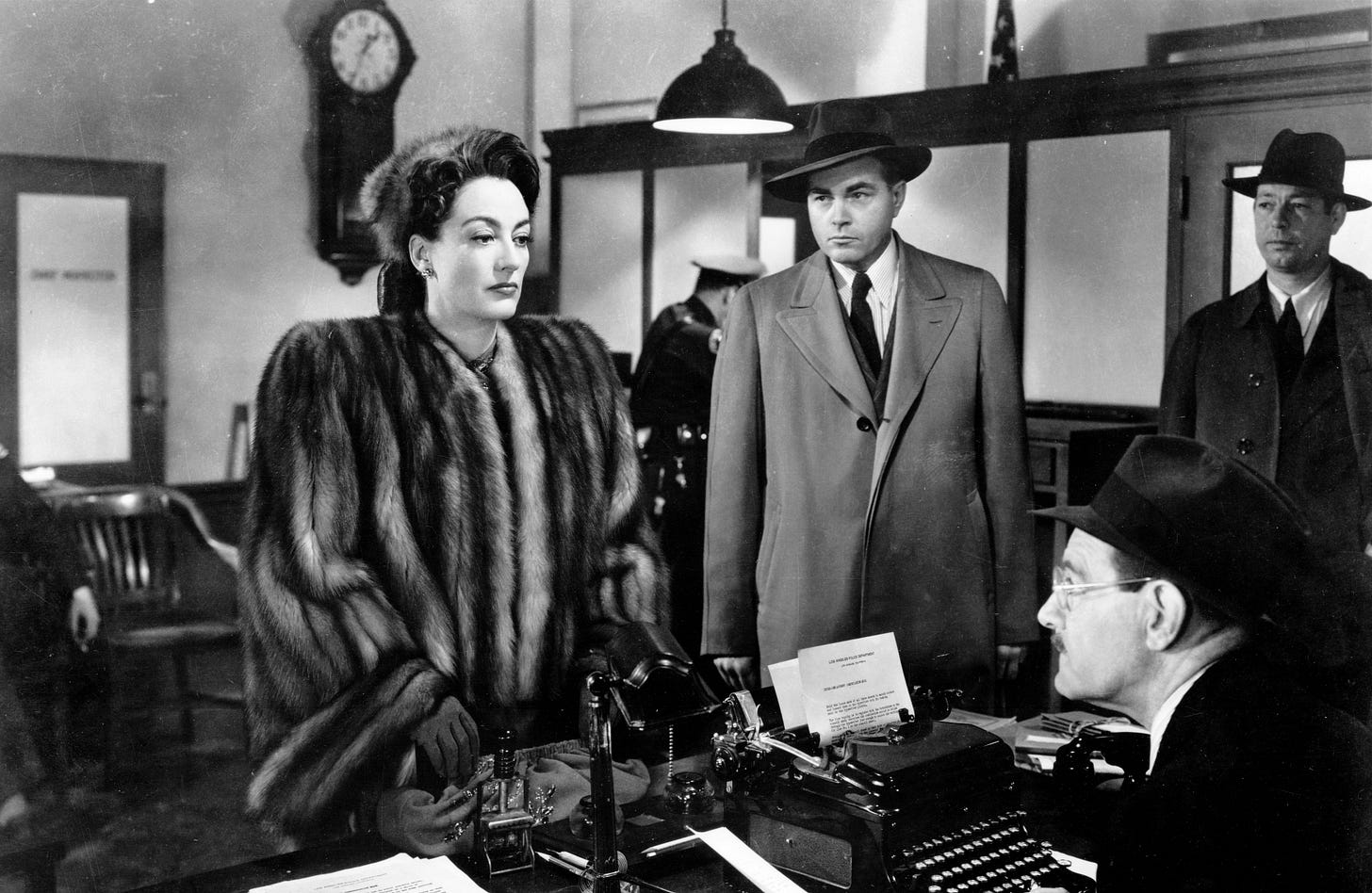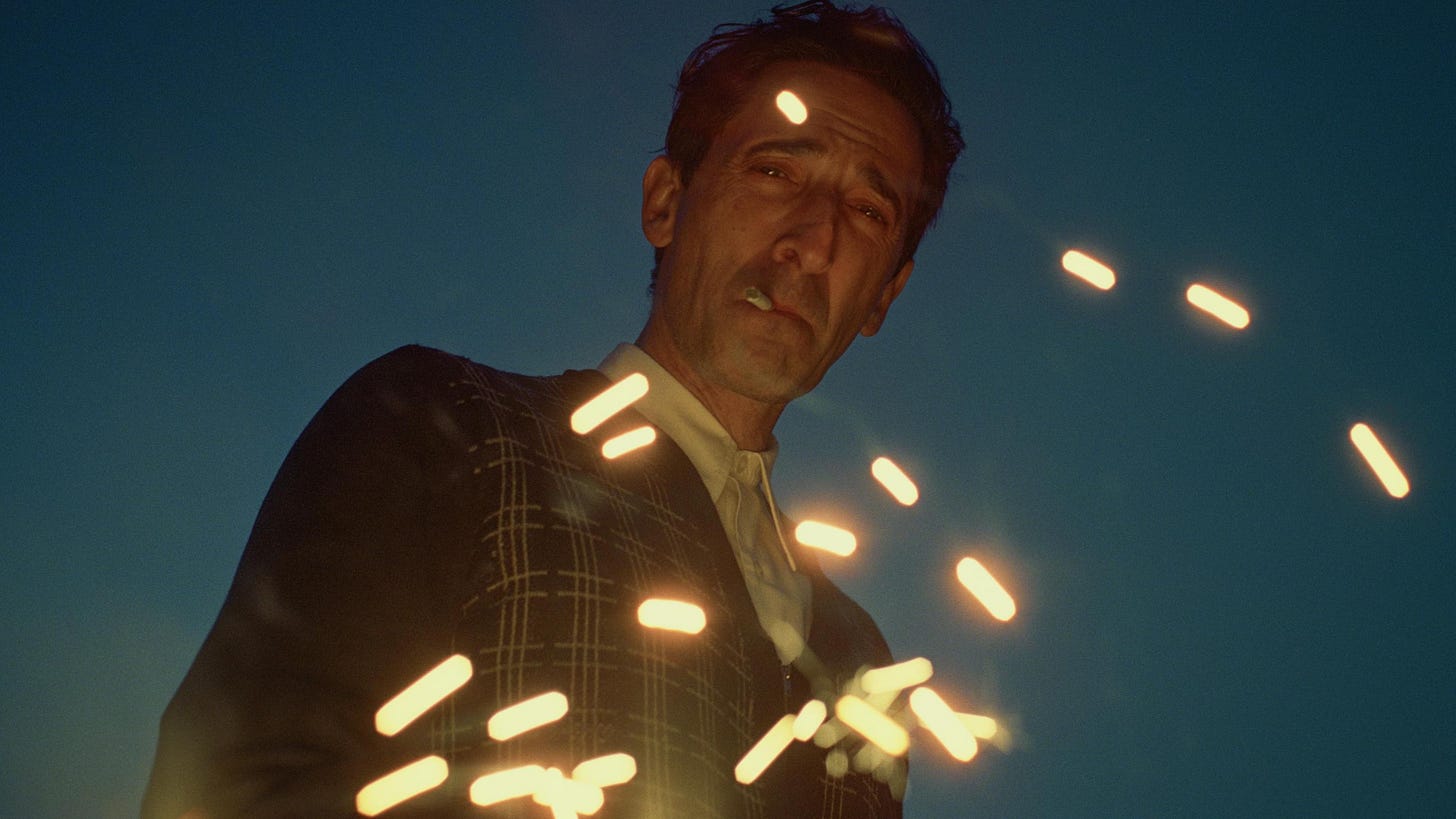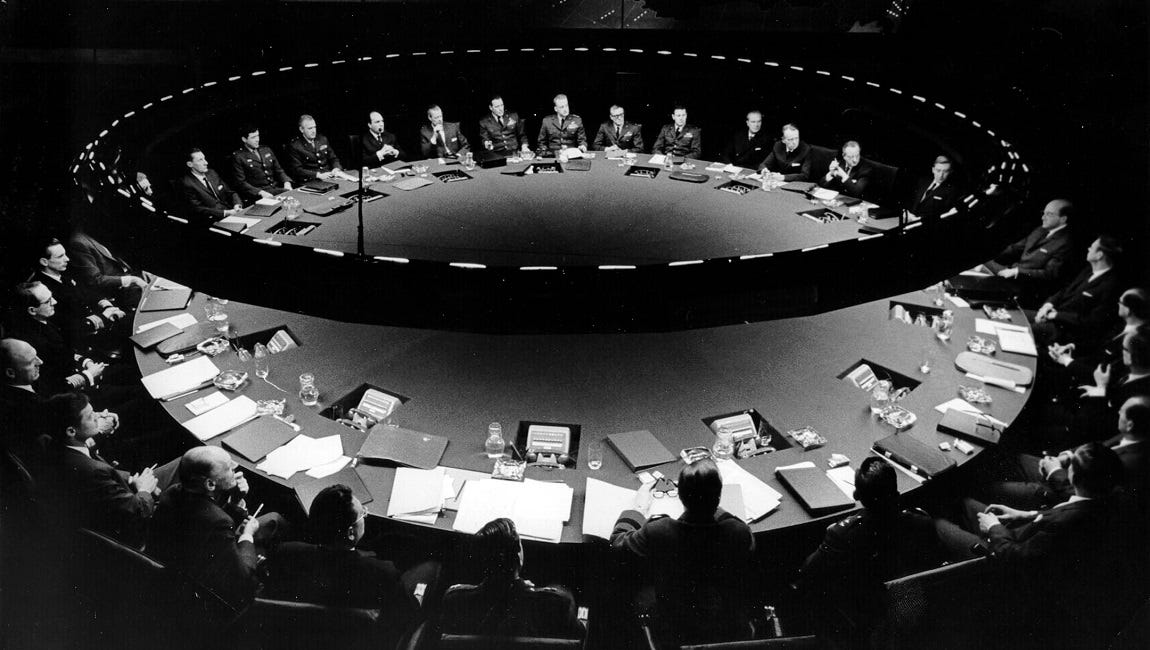Movies of the Month: January
On Frank Capra, Hitchcock and the Hays Code, 2025 Oscar Szn™, etc.
Big movie month! I rang in the new year with a screening of Frank Capra’s Mr. Deeds Goes to Town (1936) at Film Forum, then went back to see British filmmaker Matthew Wells’s documentary, Frank Capra: Mr. America (2023), for a deeper dive into the midcentury film titan. I then watched Alfred Hitchcock’s Suspicion (1941) and Joan Crawford’s Oscar-winning performance in Mildred Pierce (1945) before turning my attention toward some of this year’s Academy Award nominees, then finally seeing Stanley Kubrick’s Dr. Strangelove (1964).
Let’s get into it:
Mr. Deeds Goes to Town (1936, dir. Frank Capra) — As someone on Letterboxd so aptly put it, Gary Cooper as socialist Batman!
Frank Capra’s follow-up to his first smash hit, It Happened One Night (1934), Mr. Deeds Goes to Town (1936) tells the story of tuba-playing greeting card poet Longfellow Deeds (played by Cooper), an everyman from Mandrake Falls, Vermont who makes the move to Manhattan after inheriting $20 million — yes, in 1936 dollars — from his uncle. Sharks circle as soon as he arrives in the city. “Mocked as a ‘cornfed bohunk,’ and then, thanks to the wily reporter Babe Bennett (played by Jean Arthur), cast in the press as the clueless ‘Cinderella Man,’” per J. Hoberman for The New York Times, Deeds must decide who and who not to trust.
Capra characters often take the form of a midcentury David up against a systemic Goliath, from legal challenges to financial constraints to government corruption. Much like the filmmaker’s later pictures, Mr. Smith Goes to Washington (1939) and It’s a Wonderful Life (1946), Mr. Deeds Goes to Town deals with themes of the individual versus the collective, hoarding versus sharing wealth, and small town life versus big city culture through the prism of tragicomedy. As Hoberman explains, “Deeds is a populist myth. We…understand that Deeds speaks the language of the people when he uses the vernacular term ‘doodler,’ as in one who draws doodles, and is obliged to define it for the New York swells.” Run, don’t walk!
Where to Watch: Amazon Prime Video ($3.59)
Frank Capra: Mr. America (2023, dir. Matthew Wells) — This British-produced documentary examines the life of Sicilian immigrant turned midcentury film titan Frank Capra. After entering the United States via New York Harbor, Capra and his family settled in Los Angeles’s Lincoln Heights. Thanks to a dedicated teacher, Capra attended Manual Arts High School, then Caltech, despite his parents’ desire to put him to work instead. With the film industry in its incept, Capra took cleaning jobs on sound stages, then worked his way up into production.
Frank Capra: Mr. America (2023) traces the dual rise of Capra and Columbia Pictures. At the dawn of the 1930s, Columbia Pictures held the position of the best B-tier studio, still a ways down the totem pole from giants like Paramount and MGM. With It Happened One Night (1934), a pre-Code classic that stars Clark Gable and Claudette Colbert dragged their feet to create, the studio and director skyrocketed. The film, now credited with creating the blueprint for the contemporary rom com, took home all five major Oscars — Best Picture, Best Director, Best Actor, Best Actress, and Best Adapted Screenplay — at the 1934 Academy Awards. This success led to Capra’s conviction that his subsequent films must “say something,” to the development of Mr. Deeds Goes to Town (1936), Mr. Smith Goes to Washington (1939), and, of course, It’s a Wonderful Life (1946).
Interviewees — including Hollywood historian Sam Wasson, whose perspective I’ve referenced in past newsletters — help create a balanced image of Capra. They address his World War II propaganda filmmaking, contributions to the Hollywood blacklist, and position as a populist fabulist, acknowledging rather than shying away from the reality of his racism and Conservatism. Deadline’s Diana Lodderhose writes:
His later life saw him join the talk show circuit while he was in the process of promoting an autobiography, a book that Wells describes as “very charming but not particularly accurate.”
Fortunately, the filmmakers were able to find material where Capra is much more candid and less controlling about the image he was putting out into the world. “I didn’t think we would necessarily find that, and I thought were going to have to unpick his interviews and do much more fact checking but we did find these materials where he is being very unguarded and he’s talking about his life so that was a very welcome surprise,” says Wells.
Lodderhouse ultimately characterizes the documentary as “a deep dive into how Capra embodied the idea of the American Dream both in front of and behind the camera.” Wells positions that American Dream as a mirage Capra helped create, explaining: “His life embodies the same myth that his films are creating so it seemed very logical to try and look at the two things in parallel to his life story.” As Roger Ebert writes in his obituary for Capra, “Mr. Capra Went to Hollywood”:
The term “Capraesque” is used by today’s film critics as a word of both praise and blame — praise when they agree with a film’s portrait of the common man standing up against the system, blame if they think a film is too sentimental or corny. Frank Capra, who outlived his films by 30 years, was never able to understand the negative connotations of “Capraesque,” and perhaps that was one source of his strength as a director.
Where to Watch: Amazon Prime Video ($3.99)
Suspicion (1941, dir. Alfred Hitchcock) — Based on British author Francis Iles’s novel, Before the Fact (1932), Suspicion (1941) once again proves Hitchcock’s thesis not to trust anyone trying to make small talk on a train. The film opens with Lina McLaidlaw (played by Joan Fontaine) and Johnnie Aysgarth (played by Cary Grant) sharing a first-class railroad car through the English countryside. Lina quickly recognizes him from the society pages, creating a faulty foundation of trust as their courtship transforms into a marriage. After their wedding, Johnnie reveals himself as a grifting gambler with no money to his name. As his suspicious behavior grows, Lina begins to question where he falls on the spectrum of sociopath to psychopath.
Per Edwin Schallert’s original review for The Los Angeles Times on the occasion of the film’s January 21, 1942, opening:
Its setting English, Suspicion can, perhaps, best be called a psychological thriller with much more emphasis on the psychological than the thriller part of the description. It is above all else a study — chiefly the study of a woman’s mind, as affected by extraneous and peculiarly undermining influences.
Truly the suite (or train) of happenings is ingeniously devised, which causes suspicion to take root in the woman’s brain and grow finally into a thorny and forbidding monster of mental vegetation…the web is tightly spun, so that at times even the audience believes as the woman does. At other times doubt intrudes. This is where Suspicion shines as especially deft and adroit, and loyal also to Hitchcock precedent for keeping both characters and spectators guessing in different ways.
The film operates in a comparable canon to George Cukor’s Gaslight (1940), which I reviewed last December. In it, “Paula Alquist (played by Bergman) returns to the London townhouse where she found her aunt-slash-guardian brutally murdered years earlier, joined by her new husband, Gregory Anton (played by Charles Boyer). After training to become an opera singer in Italy solo, followed by a two-week whirlwind romance, Paula hopes to make a fresh start. But soon, night after night, she begins hearing knocking in the walls, seeing the gas lighting dim throughout the house. When her experience differs from Gregory’s, Paula begins to question her grip on reality.”
But where Gaslight builds toward its breakneck conclusion, Suspicion fizzles out in its final moments. Anyone who considers this film Hitchock’s most dull hasn’t seen The Trouble with Harry (1955), but I definitely won’t deny that the Hays Code did its closing sequence dirty.
Where to Watch: Criterion (subscription), Amazon Prime Video ($2.99)
Mildred Pierce (1945, dir. Michael Curtiz) — What Ben Mankiewicz said. Five stars, no notes.
Where to Watch: Amazon Prime Video ($3.99)
Conclave (2024, dir. Edward Berger) — To quote the headline of Vulture Film Critic Bilge Ebiri’s review: “Is a Movie About Electing a Pope Allowed to Be This Entertaining?”
Real Housewives of the Catholic Church, Conclave (2024) opens with the death of the Pope, then follows his advisors, the College of Cardinals, as they assemble to elect his successor. Thomas Lawrence (played by Ralph Fiennes), a British cardinal and the group’s Dean, leads this meeting, called a Conclave. (I did a lot of Googling after my screening.) Within the College, whose members hail from all over the world, ideologies diverge on a spectrum of liberal to conservative. It gets ~messy~ as the different factions try to ensure success day after day, vote after vote, with Lawrence rolling out what one Letterboxd user calls the best third-act use of a photocopier since Mean Girls (2004).
As Chief Film Critic Manohla Dargis writes in her review for The New York Times:
The story coalesces around the lead candidates, a nicely balanced group of sincere, stealthy and smooth operators who soon circle Lawrence, their silver tongues wagging and hands wringing as they make their moves…Fiennes, an actor of extraordinary expressive nuance, makes the character’s struggle palpable; you can see his sorrow, and not just for the dead pope, weighing and almost tugging him down like a millstone. At one point, while seated among the other cardinals in the Sistine Chapel, he looks up at Michelangelo’s monumental The Last Judgment and fixes on the figure of a damned man, a hunched, visibly distraught soul who’s being dragged to hell by devils. It’s a moment that suggests Lawrence’s spiritual turmoil, a struggle that, in turn, expresses the larger, deeper questions — theological, organizational — facing the church.
Conclave balances moments of interiority like the one Dargis describes with sweeping images of the Cardinals as a collective. This visual push and pull encapsulates the struggle between individual ambition and collective good that comprises the core of the film, creating a kind of thematic and aesthetic consistency. In her review for RogerEbert.com, Nell Minnow writes: “Cinematographer Stéphane Fontaine makes the most of the setting’s striking visuals: the rows of cardinals in their iconic red robes, the multi-color striped uniforms of the Swiss guards, and the magnificent architectural details of the Vatican. The contrast between the vibrant colors, the masterpieces of art and design, the representation of centuries of tradition, and the human failings and petty manipulations is utterly gripping.”
Drawing from the eponymous 2016 novel by Robert Harris, filmmaker Edward Berger refracts the problems that plague politics through the lens of religion. Issues of power, gender, and greed creep into its sacred structure, underscoring the Catholic church as a bureaucracy like any secular iteration. Lawrence serves as a vehicle to espouse the notion of doubt as the only viable virtue, of certainty as something to question. Conclave builds toward an unexpected conclusion that affirms this idea; Minnow goes on: “Even in the sequestered quarters, rumors, revelations, and events take the characters on a breathing, Rubik’s Cube-style series of twists and turns. The final surprise may seem outrageous initially, but it is crafted to fit the story as satisfyingly as the last piece of a jigsaw puzzle.”
Where to Watch: ~a theater near you~, Peacock (subscription), Amazon Prime Video ($5.99)
The Brutalist (2024, dir. Brady Corbet) — What my friend Rebecca (hi, Rebecca!) called “an ambitious first draft,” The Brutalist (2024) starts off promising, then packs so much plot into its three hour and 35-minute run that its characters stay as hollow sketches. As Richard Brody writes in his review for The New Yorker: “Even with its exceptional length and its ample time frame (reaching from 1947 to 1960 and leaping ahead to 1980), it seems not unfinished but incomplete. With its clean lines and precise assembly, it’s nearly devoid of fundamental practicalities, and, so, remains an idea for a movie about ideas, an outline for a drama that’s still in search of its characters.”
The epic period drama — shot on film with stunning Days of Heaven (1978)-esque cinematography courtesy of Lol Crawley — traces the life of fictional Brutalist architect László Tóth (played impeccably by Adrien Brody). A Hungarian-Jewish Holocaust survivor, László immigrates to the United States, where gets taken under the wing of wealthy industrialist Harrison Lee Van Buren (played by Guy Pearce). His star rises, then flickers as his wife, Erzsébet (played by Felicity Jones), and niece, Zsófia (played by Raffey Cassidy as a child, Ariane Labed as an adult) join him. Antisemitism and xenophobia swell, then close in on, the family.
Brody undoubtedly delivers an Oscar-worthy performance. As Tom Gliatto writes in his PEOPLE review, it “possibly surpasses his work in The Pianist. His face is capable of a tragic, suffering sensitivity and exalted artistic inspiration, as well. He looks as if his mother had insisted that he play Franz Liszt's heroically difficult piano sonatas since the age of 2. (Actually, in a long wig he might resemble Liszt.) As he did in Pianist, he manages to represent an entire era. In the film’s most moving scenes, you’re tempted to cry along with him — possibly for him — as he tearily discusses the principles of architecture and his passion for them. Post-intermission, though, the story grows more complicated, and confusing.”
The narrative structure, in many ways, bears similarities to Gabrielle Zevin’s Tomorrow, and Tomorrow, and Tomorrow (2022). ICYMI: the novel that dominated upmarket fiction discourse in the fall of 2022 follows a pair of friends, Sam and Sadie, as they launch a video game company. It begins quiet and lifelike, with an intelligent focus on the interpersonal, then takes a sharp turn somewhere around the halfway point as machinations of plot push Zevin’s well-crafted characters to the back burner. The Brutalist falls into a similar trap. Brody goes on:
The Brutalist is made solely of the cinematic equivalent of luxury components — elements of high historical value and social import — starting with the Holocaust, American xenophobia, and the trials of creative genius. [Brady] Corbet and Mona Fastvold, his partner and co-writer, quickly add some other materials of similar weight. The movie features drug addiction (László is dependent on heroin to treat the pain of an injury that he suffered when escaping from captivity), physical disability (Erzsébet uses a wheelchair because of famine-induced osteoporosis), and postwar trauma (Zsófia has been rendered mute by her sufferings)…These themes don’t emerge in step with the action; rather, they seem to be set up backward. The Brutalist is a domino movie in which the last tile is placed first and everything that precedes it is arranged in order to make sure that it comes out right. In a way, it does, with an intense dénouement and an epilogue that’s as moving as it is vague — and as philosophically engaging as it is practically narrow and contrived.
The filmmaker’s perspective, as I see it, reeks of an onlooker’s fascination. A 36-year-old Catholic-turned-atheist from Arizona, Corbet pitches everything to the highest volume rather than letting these weighty topics live amongst a textured narrative relief. As a result, each subject becomes soap operatic, the full scope of its humanity sapped.
Where to Watch: ~a theater near you~
Dr. Strangelove, or: How I Learned to Stop Worrying and Love the Bomb (1964, dir. Stanley Kubrick) — This dark political satire from Stanley Kubrick teases out the dangers of nuclear forces in human hands. In it, insane United States Air Force Brigadier General Jack D. Ripper (played by Sterling Hayden) orders an unauthorized strike on the Soviet Union, triggering a nuclear war that the U.S. President (played by Peter Sellers, who inhabits three role across the film) sets out to stop with support from his cabinet.
Through Dr. Strangelove (1964), Kubrick captures and skewers the contours of the Cold War imagination. As Roger Ebert writes in his 1999 review, its “humor is generated by a basic comic principle: People trying to be funny are never as funny as people trying to be serious and failing. The laughs have to seem forced on unwilling characters by the logic of events. A man wearing a funny hat is not funny. But a man who doesn’t know he’s wearing a funny hat…ah, now you’ve got something. The characters in Dr. Strangelove do not know their hats are funny.”
Despite dealing primarily in humor, the film ends with a chilling sequence made all the more stark by its black-and-white palette. A series of nuclear explosions go off, set to Vera Lynn’s “We’ll Meet Again” (1939). As Ben Sherlock writes in a piece for Screen Rant: “The dark, pessimistic ending to Dr. Strangelove’s story is the most important part of Kubrick’s cinematic thesis about the inevitable fate that awaits humanity in the age of nuclear weapons.”
Where to Watch: Amazon Prime Video ($3.59)
Okay, that’s all for now! Stay tuned for the January Book Review and February newsletter.
xo,
Najet





